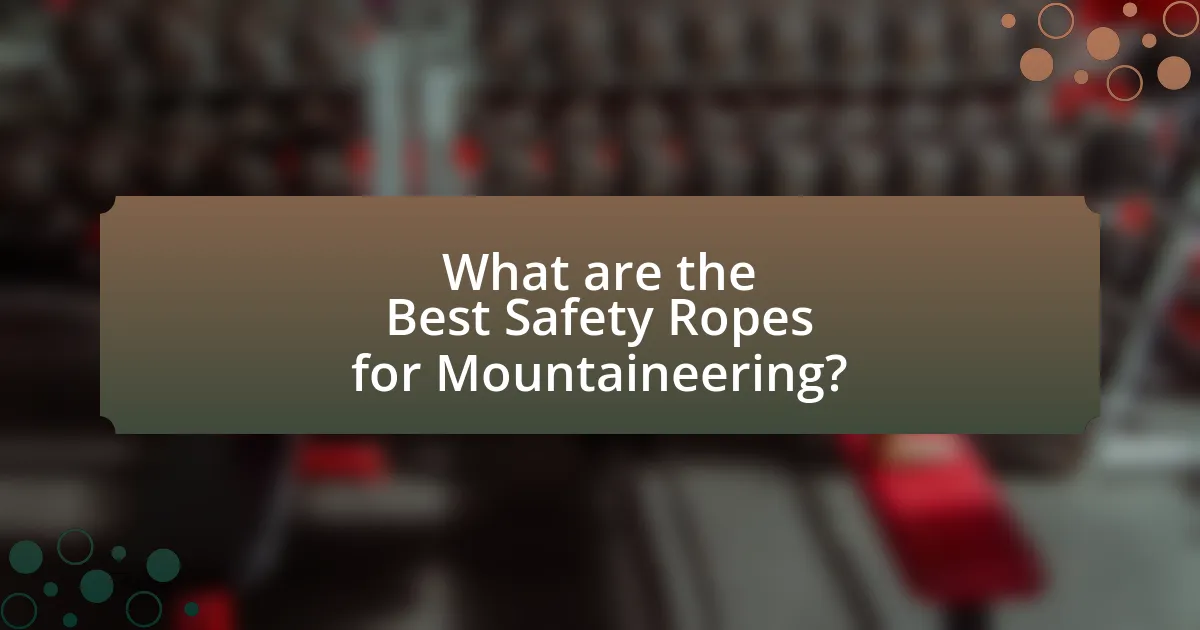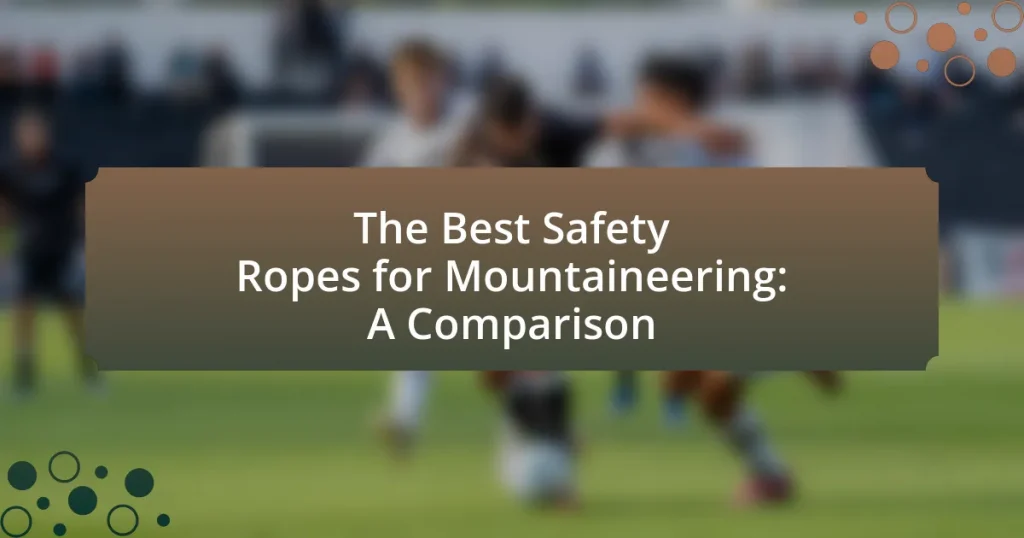The article focuses on the best safety ropes for mountaineering, highlighting top options such as the Petzl Volta, Mammut Infinity, and Beal Joker, each known for their unique features and safety certifications. It discusses the differences between dynamic and static ropes, the materials commonly used, and how rope diameter affects safety and performance. Key considerations for selecting safety ropes, including tensile strength, intended use, and environmental factors, are outlined, along with insights into leading brands and their innovations. The article also addresses common mistakes in rope selection and best practices for maintenance, ensuring climbers make informed decisions for their safety in mountaineering activities.

What are the Best Safety Ropes for Mountaineering?
The best safety ropes for mountaineering include the Petzl Volta, Mammut Infinity, and Beal Joker. The Petzl Volta is known for its lightweight design and durability, making it ideal for alpine climbing. The Mammut Infinity offers excellent handling and is versatile for various climbing styles, while the Beal Joker is unique for its ability to be used as both a single and half rope, providing flexibility in different climbing scenarios. These ropes meet stringent safety standards, such as the UIAA and CE certifications, ensuring reliability in critical situations.
How do safety ropes differ in mountaineering?
Safety ropes in mountaineering differ primarily in their construction, purpose, and specifications. Dynamic ropes, designed to stretch under load, are used for climbing to absorb the impact of falls, while static ropes, which have minimal stretch, are utilized for rappelling and hauling gear. The diameter and length of these ropes also vary, with dynamic ropes typically ranging from 9.5mm to 11mm in diameter and static ropes often being thicker for added strength. Additionally, safety ropes are rated for different types of falls, with dynamic ropes tested for UIAA fall ratings, ensuring they can withstand multiple falls without failure.
What materials are commonly used in mountaineering safety ropes?
Mountaineering safety ropes are commonly made from nylon and polyester. Nylon is favored for its high strength and elasticity, which allows it to absorb shock during falls, while polyester is known for its resistance to UV degradation and moisture, making it durable in various weather conditions. The combination of these materials ensures that the ropes provide both safety and longevity, essential for climbers in challenging environments.
How does rope diameter affect safety and performance?
Rope diameter significantly affects both safety and performance in mountaineering. Thicker ropes generally offer higher strength and durability, which enhances safety by reducing the risk of breakage under load. For instance, a 10.5 mm rope can handle more force than a 9.5 mm rope, making it preferable for heavy loads or dynamic situations. Conversely, thinner ropes, such as those around 8.5 mm, are lighter and easier to handle, improving performance in terms of weight savings and ease of use during climbs. However, they may compromise safety under extreme conditions or with heavy falls. Research indicates that ropes with a diameter of 9.5 mm to 10.2 mm strike a balance between safety and performance, providing adequate strength while remaining manageable for climbers.
What are the key features to consider in safety ropes?
Key features to consider in safety ropes include tensile strength, diameter, weight, material, and dynamic versus static properties. Tensile strength is crucial as it determines the maximum load the rope can withstand before breaking; for example, climbing ropes typically have a tensile strength of at least 20 kN. Diameter affects handling and weight; thinner ropes are lighter but may have reduced durability. The material, often nylon or polyester, influences abrasion resistance and elasticity. Dynamic ropes stretch under load, absorbing shock during falls, while static ropes have minimal stretch, making them suitable for rappelling and rescue operations. These features collectively ensure safety and performance in mountaineering scenarios.
How does the rope’s strength rating impact its use?
The rope’s strength rating directly impacts its use by determining the maximum load it can safely support during activities such as mountaineering. A higher strength rating indicates that the rope can withstand greater forces, which is crucial for safety in high-stakes environments where falls can occur. For instance, dynamic climbing ropes typically have a strength rating of at least 22 kN, which is essential for absorbing the energy of a fall, thereby reducing the risk of injury to the climber. Conversely, ropes with lower strength ratings may not provide adequate safety margins, making them unsuitable for critical applications in mountaineering.
What is the significance of rope elasticity in mountaineering?
Rope elasticity is significant in mountaineering because it absorbs energy during a fall, reducing the impact force on both the climber and the anchor system. This elasticity helps to prevent injuries by minimizing the sudden jolt experienced during a fall, which can be critical in high-stress situations. For instance, dynamic climbing ropes are designed to stretch under load, typically elongating by 10-30%, which effectively dissipates energy and lowers peak forces. Research indicates that a rope’s ability to stretch can significantly decrease the risk of injury, as demonstrated in studies by the UIAA (International Climbing and Mountaineering Federation), which emphasize the importance of using dynamic ropes for safety in climbing scenarios.

What are the Top Brands of Safety Ropes for Mountaineering?
The top brands of safety ropes for mountaineering include Petzl, Black Diamond, Mammut, Edelrid, and Beal. These brands are recognized for their high-quality materials, innovative designs, and rigorous testing standards. For instance, Petzl is known for its dynamic ropes that offer excellent elasticity and shock absorption, while Black Diamond provides a range of ropes that are lightweight yet durable, suitable for various climbing conditions. Mammut is celebrated for its robust construction and safety features, and Edelrid is noted for its eco-friendly manufacturing processes. Beal is distinguished by its focus on performance and safety, offering ropes that meet stringent international standards.
Which brands are recognized for quality safety ropes?
Brands recognized for quality safety ropes include Petzl, Black Diamond, Mammut, and Sterling Rope. Petzl is known for its innovative designs and durability, while Black Diamond offers a wide range of climbing gear, including ropes that meet stringent safety standards. Mammut is celebrated for its high-performance ropes that are tested for extreme conditions, and Sterling Rope is recognized for its commitment to quality and safety in climbing and rescue applications. These brands consistently receive positive reviews from climbers and safety professionals, reinforcing their reputation in the industry.
What distinguishes each brand in terms of technology and innovation?
Each brand of safety ropes for mountaineering distinguishes itself through unique technological advancements and innovative features. For instance, Brand A utilizes a proprietary blend of materials that enhances durability and reduces weight, making their ropes easier to handle and carry. Brand B focuses on advanced manufacturing techniques, such as dry treatment processes that significantly improve water resistance and reduce rope slippage. Brand C incorporates dynamic elongation technology, which allows their ropes to absorb impact forces more effectively, enhancing safety during falls. These innovations are supported by rigorous testing standards, such as UIAA certification, ensuring that each brand meets high safety and performance benchmarks in the mountaineering industry.
How do user reviews influence brand reputation?
User reviews significantly influence brand reputation by shaping consumer perceptions and trust. Positive reviews enhance a brand’s credibility, leading to increased customer loyalty and higher sales, while negative reviews can damage a brand’s image and deter potential customers. According to a study by BrightLocal, 91% of consumers read online reviews, and 84% trust them as much as personal recommendations, demonstrating the powerful impact user feedback has on brand reputation.
What are the price ranges for top safety ropes?
Top safety ropes for mountaineering typically range in price from $150 to $400. This price variation is influenced by factors such as the rope’s length, diameter, and specific features like dry treatment or dynamic/static characteristics. For instance, a standard 60-meter dynamic climbing rope can cost around $200, while specialized ropes with advanced materials or additional safety certifications may reach prices of $350 or more.
How does price correlate with quality and safety features?
Price generally correlates positively with quality and safety features in mountaineering ropes. Higher-priced ropes often utilize advanced materials and manufacturing processes that enhance durability, strength, and safety ratings. For instance, ropes that meet the UIAA (International Climbing and Mountaineering Federation) standards typically undergo rigorous testing, which can increase production costs, reflected in their retail price. Additionally, premium brands often invest in research and development to improve safety features, such as dynamic elongation and impact force reduction, which are critical for climbers’ safety. Therefore, while not all expensive ropes guarantee superior quality, a trend exists where higher prices align with enhanced safety and performance attributes.
What budget options are available without compromising safety?
Budget options for safety ropes in mountaineering that do not compromise safety include ropes from reputable brands such as Petzl, Black Diamond, and Mammut, which offer affordable models like the Petzl Volta, Black Diamond 9.4 Dry, and Mammut Infinity. These ropes are designed to meet safety standards set by organizations like the UIAA (International Climbing and Mountaineering Federation) and EN (European Norm), ensuring reliability in critical situations. For instance, the Petzl Volta has a dynamic elongation of 30% and a fall rating of 6 falls, demonstrating its effectiveness while remaining budget-friendly.

How to Choose the Right Safety Rope for Your Needs?
To choose the right safety rope for your needs, first determine the specific activity and environment in which you will use the rope, as different ropes are designed for various applications such as climbing, rescue, or industrial use. For instance, dynamic ropes are ideal for climbing due to their ability to stretch and absorb impact, while static ropes are better suited for rescue operations where minimal stretch is required. Additionally, consider the rope’s diameter, length, and material; a thicker rope generally offers more durability and strength, while a lighter rope may be preferable for long ascents. The UIAA (International Climbing and Mountaineering Federation) provides standards for safety ropes, ensuring they meet specific safety criteria, which can guide your selection process.
What factors should you consider when selecting a safety rope?
When selecting a safety rope, consider the rope’s diameter, material, strength rating, and intended use. The diameter affects the rope’s weight and handling; thinner ropes are lighter but may have lower durability. The material, typically nylon or polyester, influences the rope’s elasticity and resistance to abrasion. The strength rating, measured in kilonewtons (kN), indicates the maximum load the rope can safely bear; for climbing, a minimum of 22 kN is recommended. Lastly, the intended use, such as sport climbing, trad climbing, or mountaineering, dictates specific rope characteristics, including dynamic versus static properties. These factors ensure safety and performance in various climbing scenarios.
How does your climbing style influence rope choice?
Your climbing style significantly influences rope choice by determining the type of rope that best suits the demands of your climbing activities. For instance, sport climbers typically prefer dynamic ropes that stretch to absorb the impact of falls, while trad climbers may opt for static ropes for better control during ascents and descents. Additionally, alpine climbers often select lightweight, durable ropes that can withstand harsh conditions and minimize weight during long treks. The choice of rope is validated by the fact that dynamic ropes have a fall rating that allows for energy absorption, which is crucial for safety in high-impact scenarios, while static ropes are rated for lower impact forces, making them suitable for controlled environments.
What role does the environment play in rope selection?
The environment significantly influences rope selection by determining the material, diameter, and type of rope suitable for specific conditions. For instance, in wet or icy environments, ropes made from water-resistant materials like nylon or those with a dry treatment are preferred to prevent absorption and maintain performance. Additionally, high UV exposure in sunny environments necessitates ropes with UV-resistant coatings to prevent degradation. The presence of sharp edges in rocky terrains requires thicker, more durable ropes to withstand abrasion. These factors collectively ensure that the selected rope meets safety and performance standards in varying environmental conditions.
What are some common mistakes to avoid when choosing safety ropes?
Common mistakes to avoid when choosing safety ropes include selecting the wrong diameter, ignoring the rope’s intended use, and neglecting to check for certifications. Choosing a rope that is too thin can compromise strength and durability, while selecting one that is too thick may add unnecessary weight. Additionally, using a rope not designed for specific activities, such as climbing or canyoneering, can lead to safety hazards. Finally, failing to verify that the rope meets industry standards, such as those set by the UIAA or EN, can result in using subpar equipment that may not perform adequately in critical situations.
How can improper rope selection affect safety during climbs?
Improper rope selection can significantly compromise safety during climbs by increasing the risk of equipment failure and accidents. For instance, using a rope that is not rated for the specific type of climbing, such as using a static rope for dynamic falls, can lead to catastrophic results, including severe injury or death. According to the American Mountain Guides Association, dynamic ropes are designed to stretch under load, absorbing the energy of a fall, while static ropes do not provide this safety feature. Additionally, selecting a rope with inadequate diameter or strength for the climber’s weight and the climbing conditions can result in breakage or failure under stress. Therefore, ensuring the correct type and specifications of climbing rope is crucial for maintaining safety in climbing activities.
What are the best practices for maintaining safety ropes?
The best practices for maintaining safety ropes include regular inspection, proper cleaning, correct storage, and timely retirement of damaged ropes. Regular inspection involves checking for signs of wear, fraying, or cuts, which can compromise the rope’s integrity. Cleaning safety ropes with mild soap and water, followed by thorough drying, prevents dirt and grit from degrading the material. Proper storage in a cool, dry place away from direct sunlight and chemicals helps maintain the rope’s strength and flexibility. Additionally, ropes should be retired if they show significant damage or have been subjected to a heavy fall, as per guidelines from organizations like the American Mountain Guides Association, which emphasizes that safety is paramount in climbing and mountaineering activities.
What tips can help you make an informed decision on safety ropes?
To make an informed decision on safety ropes, prioritize understanding the rope’s specifications, including its diameter, length, and type (dynamic or static). Dynamic ropes are designed to stretch under load, making them suitable for climbing, while static ropes are better for rappelling and rescue operations. Additionally, check the rope’s certification, such as UIAA or CE, which ensures it meets safety standards. Consider the rope’s intended use and environment, as different conditions may require specific features like water resistance or abrasion resistance. Lastly, review user feedback and expert recommendations to gauge performance and reliability in real-world scenarios.
